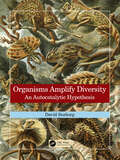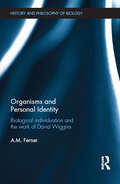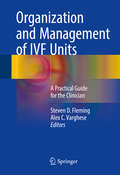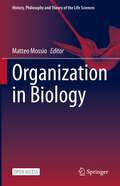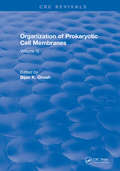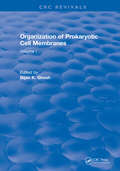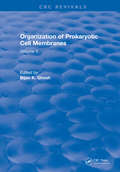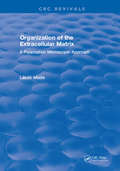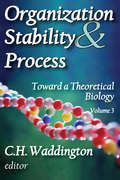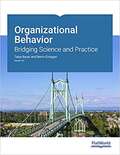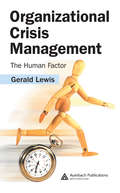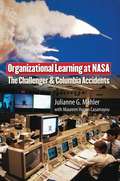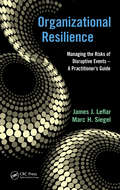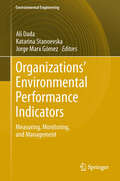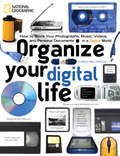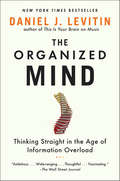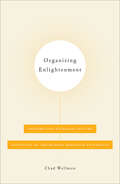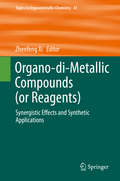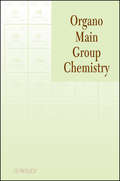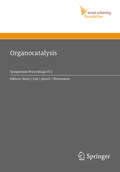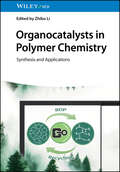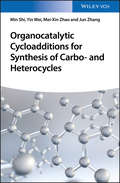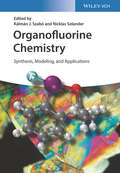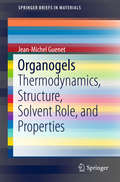- Table View
- List View
Organisms Amplify Diversity: An Autocatalytic Hypothesis
by David SeaborgThis book presents a hypothesis and evidence that organisms promote and ecosystems maximize biodiversity. All species have a net positive effect on their environment, other species, and diversity. The sun is 30% hotter than when life began, but the temperature has been kept moderate by life. Life created high oxygen, the ozone layer, and fertile soil, a diverse, living system. No species evolves in isolation, and most evolution is coevolution. The nature and number of links between species are as important as species number. Eukaryotes coevolve with complex ecosystems of microbes with which they exchange genes. Genomes and intraspecific interactions both act to promote evolution and diversification. Viruses increase diversity of their hosts and cause macroevolutionary transitions. Key Features Life alters the Earth in ways that increase biodiversity All species make their environment better for other species and promote diversity Life created the life-friendly atmosphere, temperature, and soil of today
Organisms and Personal Identity: Individuation and the Work of David Wiggins (History and Philosophy of Biology)
by A.M. FernerOver his philosophical career, David Wiggins has produced a body of work that, though varied and wide-ranging, stands as a coherent and carefully integrated whole. In this book Ferner examines Wiggins’ conceptualist-realism, his sortal theory ‘D’ and his human being theory in order to assess how far these elements of his systematic metaphysics connect. In addition to rectifying misinterpretations and analysing the relations between Wiggins’ works, Ferner reveals the importance of the philosophy of biology to Wiggins’ approach. This book elucidates the biological anti-reductionism present in Wiggins’ work and highlights how this stance stands as a productive alternative to emergentism. With an analysis of Wiggins’ construal of substances, specifically organisms, the book goes on to discuss how Wiggins brings together the concept of a person with the concept of a natural substance, or human being. An extensive introduction to the work of David Wiggins, as well as a contribution to the dialogue between personal identity theorists and philosophers of biology, this book will appeal to students and scholars working in the areas of philosophy, biology and the history of Anglophone metaphysics.
Organisms-From Macro to Micro: Student Guide and Source Book
by National Science Resources CenterTextbook.
Organization and Management of IVF Units
by Steven D. Fleming Alex C. VargheseBringing together the latest information on the organization, management and quality of in-vitro fertilization (IVF) units, this is the first true field guide for the clinician working in assisted reproductive technologies (ART). Divided thematically into four main sections, part one discussed the establishment and organization of the IVF unit, including location, design and construction, practical considerations for batching IVF cycles, and regulations and risk management. Part two, the largest section, covers the many aspects of overall quality management and its implementation - staff and patient management, cryobank and PGD/PGS management, and data management - as well as optimization of treatment outcomes and statistical process control analysis to assess quality variation. Part three addresses the relationship between IVF units and society at large, including the ethics of IVF treatment, as well as public/low-cost and private/corporate IVF units. Advertising and marketing for IVF units is discussed in part four, including the building and managing of websites and the use of traditional print and social media. With approximately five thousand IVF units worldwide and a growing number of training programs, Organization and Management of IVF Units is a key resource for clinic directors, unit managers, embryologists, quality experts, and students of reproductive medicine and clinical embryology.
Organization in Biology (History, Philosophy and Theory of the Life Sciences #33)
by Matteo MossioThis open access book assesses the prospects of (re)adopting organization as a pivotal concept in biology. It shows how organization can nourish biological thinking and practice, by reconnecting with the idea of biology as the science of organized systems. The book provides a comprehensive state-of-the-art picture of the characterizations and uses of the concept of organization in both biological science and philosophy of biology. It also deals with a variety of themes – including evolution, organogenesis, heredity, cognition and ecology – with respect to which the concept of organization can guide the elaboration of original models and new experimental protocols. It will be of interest to biologists and scholars working in philosophy of science alike.
Organization of Prokaryotic Cell Membranes: Volume III
by GhoshThese volumes include a collection of authoritative articles covering the most active areas of prokaryotic biomembrane investigations, and will provide a great service not only to those interested in the field but also to microbiologists in general. These monographs will also serve to focus attention on prokaryotic membranes that are so often ignored by eukaryoticmembraneologists and proved an excellent reference source for many years to come.
Organization of Prokaryotic Cell Membranes: Volume I
by Bijan K. GhoshThis book has information about prokaryotes, prokaryotes are single-celled organisms that are the earliest and most primitive forms of life on earth. As organized in the Three Domain System, prokaryotes include bacteria and archaeans. Some prokaryotes, such as cyanobacteria, are photosynthetic organisms and are capable of photosynthesis. There are sections in this book that explain the role of membranes in transport, about bioenergetics of bacteria cells, Mycoplasma, immunology of bacteria membrane and receptors.
Organization of Prokaryotic Cell Membranes: Volume II
by Bijan K. GhoshThese volumes include a collection of authoritative articles covering the most active areas of prokaryotic biomembrane investigations, and will provide a great service not only to those interested in the field but also to microbiologists in general. These monographs will also serve to focus attention on prokaryotic membranes that are so often ignored by eukaryoticmembraneologists and proved an excellent reference source for many years to come.
Organization of the Extracellular Matrix: A Polarization Microscopic Approach
by Laszlo ModisThis book describes analysis techniques and results of topics such as physical backgrounds, chemical backgrounds, and principal methods of topo-optical reactions used in ultrastructure research of the ECM; orientation patterns of GAGs and collagen in different tissues/cartilage, cornea, kidney basement membranes, and skin; factors involved in the formation of submicroscopically ordered matrix structure; and cell-matrix interactions, including cytoskeleton-cell-membrane-matrix relationships. A summarization of the advantages and limitations of polarization microscopy compared to electron microscopy in ultracellular research is also included. Cell biologists, histologists, pathologists, and biochemists in connective tissue research will find this book to be an invaluable reference tool.
Organization Stability and Process: Volume 3 (Toward a Theoretical Biology)
by C. H. WaddingtonThis is the third, penultimate volume in the Toward a Theoretical Biology series. The contributors agree that there is a major problem in finding methods of dealing with the great complexity of biological systems. Molecular biology has given us considerable insight into the nature of the elementary units and processes of life, but to understand how these are put together to form systems that are usually too complicated to be analysed completely, but exhibit global properties of simplicity, presents biologists with an intellectual challenge that physical sciences and chemistry must also face. The problem is approached from several different angles: quantum physics, topology, and statistical mechanics. A stimulating discussion is recorded: that the behaviour of randomly constructed networks exhibits simplicity. Thoughtful analyses of complexities in such basic biological processes as the genetic control of differentiation, evolution, and ecology is also included. Some of the questions dealt with are: What kinds of theories should we wish to have in connection with developmental biology? And have we got them? The subject matter of 'Organization Stability and Process' is defined as the basic concept of biology. None of the contributors herein contained is a molecular biologist in the modern sense, but molecular biology casts a shadow over this work, at least in so far as they challenge its interpretative aggressiveness and its enthusiastic but unendearing self-confidence and self-sufficiency. This volume inaugurates a new and authentic style of scientific literature. The contributions are thoughtful, imaginative, illuminating, and exceptionally well written.
Organizational Behavior: Bridging Science and Practice Version 4.0
by Talya Bauer Berrin ErdoganThis textbook incorporates effective ways to bridge the gap between the theory and practice of management with the distinct, experiential, and evidence-based approach for which this book is known. Organizational Behavior provides the most timely and relevant concepts, vocabulary, frameworks, and critical-thinking skills necessary to diagnose situations, ask tough questions, evaluate answers received, and act in an effective and ethical manner taking into consideration the specific situational characteristics.
Organizational Crisis Management: The Human Factor
by Gerald LewisOrganizational Crisis Management: The Human Factor offers theoretical background and practical strategies for responding to workplace crises. Responding to a paradigm that focuses on the operational aspects of continuity to the detriment of human factors, this volume provides a comprehensive understanding of the unavoidable yet often complex reacti
Organizational Learning at NASA: The Challenger and the Columbia Accidents
by Julianne Mahler Maureen Hogan CasamayouJust after 9:00 a. m. on February 1, 2003, the space shuttle Columbia broke apart and was lost over Texas. This tragic event led, as the Challenger accident had 17 years earlier, to an intensive government investigation of the technological and organizational causes of the accident. The investigation found chilling similarities between the two accidents, leading the Columbia Accident Investigation Board to conclude that NASA failed to learn from its earlier tragedy. Despite the frequency with which organizations are encouraged to adopt learning practices, organizational learning--especially in public organizations--is not well understood and deserves to be studied in more detail. This book fills that gap with a thorough examination of NASA's loss of the two shuttles. After offering an account of the processes that constitute organizational learning, Julianne G. Mahler focuses on what NASA did to address problems revealed by Challenger and its uneven efforts to institutionalize its own findings. She also suggests factors overlooked by both accident commissions and proposes broadly applicable hypotheses about learning in public organizations.
Organizational Resilience: Managing the Risks of Disruptive Events - A Practitioner's Guide
by Marc H. Siegel James J. LeflarMoving towards resiliency is more than just implanting policy and procedure; it is a process that takes organizations on a winding path requiring patience and tolerance. A good deal of learning will have to take place during the trip and that is why it is necessary to have patience and tolerate the learning process. Organizational Resilience: Manag
Organizations’ Environmental Performance Indicators
by Ali Dada Jorge Marx Gómez Katarina StanoevskaThe book provides a collection of individual chapters from the participants in the OEPI project, which represent a mix of academic and practical chapters and contributions. The first part of the book is dedicated to a theoretical introduction to Organisations' Environmental Performance Indicators and to a state-of-the-art overview in literature and practice. The second part of the book contains several chapters describing information systems and their components supporting the management of Environmental Performance Indicators, especially in inter-organizational contexts. The third part is dedicated to three case studies from practice, and the book concludes with part four, in which practical guidelines for the innovative management of Environmental Performance indicators in organizations and in inter-organizational contexts are presented.
Organize Your Digital Life: How to Store Your Photographs, Music, Videos, and Personal Documents in a Digital World
by Aimee BaldridgeThis book delivers basic step-by-step instruction on streamlining and organizing your digital life, so you can find what you need instantly and create presentations your friends and family will love.
The Organized Mind: Thinking Straight In The Age Of Information Overload
by Daniel J LevitinThe information age is drowning us in an unprecedented deluge of data. At the same time, we’re expected to make more—and faster—decisions about our lives than ever before. No wonder, then, that the average person reports frequently losing car keys or reading glasses, missing appointments, and feeling worn out by the effort required just to keep up. But somehow some people become quite accomplished at managing information flow. In The Organized Mind, Daniel J. Levitin, Ph.D., uses the latest brain science to demonstrate how those people excel—and how readers can use these methods to regain a sense of mastery over the way they organize their homes, workplaces, and lives. With lively, entertaining chapters on everything from the kitchen junk drawer to health care to gambling in Las Vegas, Levitin reveals how new research into the cognitive neuroscience of attention and memory can be applied to daily life. His practical suggestions call for relatively minor changes that require little effort but will have remarkable long-term benefits for mental and physical health, productivity, and creativity. This Is Your Brain on Music showed us how to better play and appreciate music through an understanding of how the brain works. The Organized Mind shows us how to navigate the churning flow of information in our daily lives with the same neuroscientific perspective.
Organizing Enlightenment: Information Overload and the Invention of the Modern Research University
by Chad WellmonThe Enlightenment-era concerns that gave rise to the modern research university can illuminate contemporary debates about knowledge in the digital age.Since its inception, the research university has been the central institution of knowledge in the West. Today its intellectual authority is being challenged on many fronts, above all by radical technological change. Organizing Enlightenment tells the story of how the university emerged in the early nineteenth century at a similarly fraught moment of cultural anxiety about revolutionary technologies and their disruptive effects on established institutions of knowledge.Drawing on the histories of science, the university, and print, as well as media theory and philosophy, Chad Wellmon explains how the research university and the ethic of disciplinarity it created emerged as the final and most lasting technology of the Enlightenment. Organizing Enlightenment reveals higher education’s story as one not only of the production of knowledge but also of the formation of a particular type of person: the disciplinary self. In order to survive, the university would have to institutionalize a new order of knowledge, one that was self-organizing, internally coherent, and embodied in the very character of the modern, critical scholar.
Organo-di-Metallic Compounds (or Reagents)
by Zhenfeng XiThe series Topics in Organometallic Chemistry presents critical overviews of research results in organometallic chemistry. As our understanding of organometallic structure, properties and mechanisms increases, new ways are opened for the design of organometallic compounds and reactions tailored to the needs of such diverse areas as organic synthesis, medical research, biology and materials science. Thus the scope of coverage includes a broad range of topics in pure and applied organometallic chemistry, where new breakthroughs are being achieved that are of significance to a larger scientific audience. The individual volumes of Topics in Organometallic Chemistry are thematic. Review articles are generally invited by the volume editors.
Organo Main Group Chemistry
by Kin-ya AkibaForging a new association; main group elements and organic chemistry Covering the essentials of all main group elements in organic chemistry, along with the synthesis and reactions of their organic compounds in just one volume, Organo Main Group Chemistry breaks important new ground. While main group chemistry has traditionally been classified as part of inorganic chemistry, this book establishes the organic chemistry of main group elements for the first time. The organic compounds of elements in the second period of the periodic table, which are centered around carbon, are the major components of animals and plants, while those in the third period and below also play key roles worthy of discussion when studying main group element chemistry. The major chapters describe synthesis and reactivity of organic compounds in the third period and below and are arranged according to the order of the periodic table. Starting with the role of lithium and magnesium cations, the chapters reach fluorine and iodine compounds. The first two chapters summarize the unique and common characteristics of main group elements in relation to carbon. The latter chapters deal with modern topics that address the unique characteristics of organo main group compounds. Suitable for professional researchers, chemistry professors, and advanced students, Organo Main Group Chemistry presents a novel new approach to the way we view both main groups and organic chemistry itself.
Organocatalysis
by Hilmar Weinmann Benjamin List Stefan Jaroch Manfred ReetzThis book provides an excellent overview on state-of-the-art of modern organocatalysis. It presents the contributions from leading experts, with backgrounds in academia and industry, to an Ernst Schering Research Foundation Symposium held in April 2007. It will be of interest to those who want a general overview of the topic, but also to those who want to learn more about the state-of-the-art, current trends and perspectives in this highly dynamic field of research.
Organocatalysts in Polymer Chemistry: Synthesis and Applications
by Zhibo LiProvides an up-to-date overview of organocatalysis in polymer chemistry, covers recent innovations and specific methodologies Organocatalysis is revolutionizing polymer chemistry, offering a sustainable, cost-effective alternative to traditional metal-based catalysts. Organocatalysts in Polymer Chemistry: Synthesis and Applications presents a detailed summary of the development of organocatalysts and their transformative impact on polymer synthesis. Contributions by an international team of specialists present cutting-edge methodologies for creating precise macromolecular structures, covering a wide range of polymerization methods and practical applications. Edited by Professor Zhibo Li, an acknowledged expert in polymer chemistry, the book covers the use of organocatalysts in processes such as ring-opening polymerization, controlled radical polymerization, and polymer depolymerization. It offers vital insights into the synthesis of advanced, biodegradable, and metal-free materials, making it a valuable resource of both foundational knowledge and the latest research breakthroughs in polymer chemistry. Exploring the development, advantages, and applications of organocatalysts in polymer synthesis, this book: Presents advanced techniques for creating precise polymer architectures, including molecular weight, stereochemistry, and topology control Discusses applications of organocatalysts in ring-opening polymerization (ROP), controlled radical polymerization, and copolymerization techniques Highlights organocatalysis as a metal-free, cost-effective, and environmentally friendly alternative for polymer synthesis Examines the role of organocatalysts in recycling and depolymerizing commodity polymers such as PET and polycarbonate Addresses the synthesis of degradable polymers for biomedical, electronic, and environmental uses Summarizes advancements over the past two decades and explores emerging trends in polymer chemistry Organocatalysts in Polymer Chemistry is essential reading for postgraduate students, researchers, and industrial professionals in polymer chemistry, materials science, and sustainable catalysis. It is also an essential reference for catalytic chemists, organic chemists, and chemical engineers engaged in the synthesis and application of polymers.
Organocatalytic Cycloadditions for Synthesis of Carbo- and Heterocycles
by Min Shi Yin Wei Mei-Xin Zhao Jun ZhangOrganocatalytic Cycloadditions for Synthesis of Carbo- and Heterocycles offers a clear explanationto thedevelopment of and the information on the latest research pertaining to zwitterion-oriented cycloadditions promoted by organoamines, organophosphines, N-heterocyclic carbenes. The authors—noted experts in the field—include a comprehensive review to the investigations of the reaction mechanisms and explore the synthesis of different products from the same starting materials. Filled with illustrative examples and designed to be accessible, the text shows how to control the chemo-, regio- and stereoselectivity and explains the further design of novel cycloaddition reactions catalyzed by organoamines and organophosphines based on zwitterion-oriented synthetic strategy.
Organofluorine Chemistry: Synthesis, Modeling, and Applications
by SzaboBy presenting novel methods for the efficient preparation of fluorinated compounds and their application in pharmaceutical and agrochemical chemistry as well as medicine, this is a valuable source of information for all researchers in academia and industry!
Organogels
by Jean-Michel GuenetThis book provides a physics-oriented introduction to organogels with a comparison to polymer thermoreversible gels whenever relevant. The past decade has seen the development of a wide variety of newly-synthesized molecules that can spontaneously self-assemble or crystallize from their organic or aqueous solutions to produce fibrillar networks, namely organogels, with potential applications in organic electronics, light harvesting, bio-imaging, non-linear optics, and the like. This compact volume presents a detailed outlook of these novel molecular systems with special emphasis upon their thermodynamics, morphology, molecular structure, and rheology. The definition of these complex systems is also tackled, as well as the role of the solvent. The text features numerous temperature-phase diagrams for a variety of organogels as well as illustrations of their structures at the microscopic, mesoscopic and macroscopic level. A review of some potential applications is provided including hybrid functional materials with polymers and with carbon nanotubes. Throughout, discussions of theoretical developments and experimental advances are written at a level suitable for beginning graduate students through practicing researchers.
